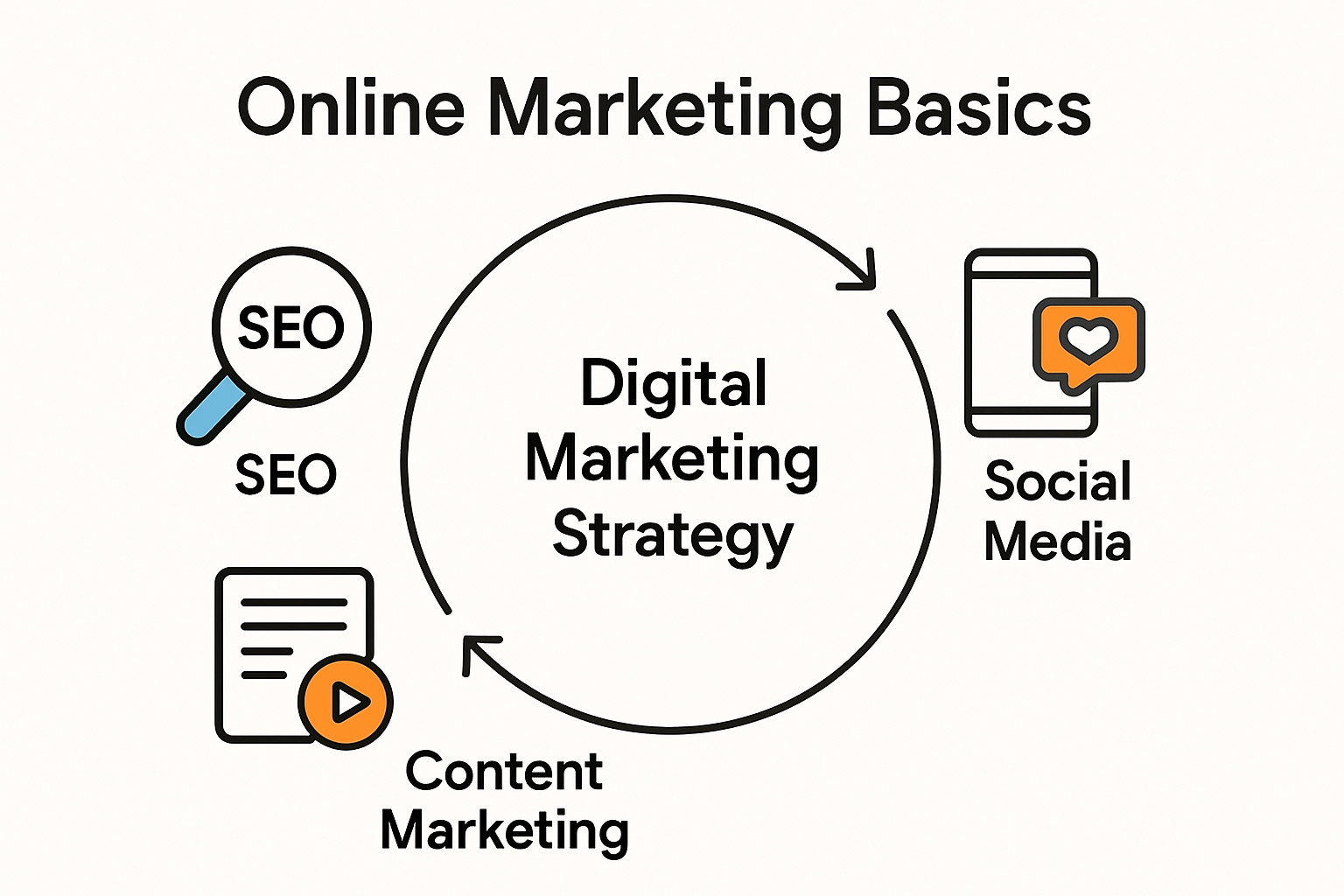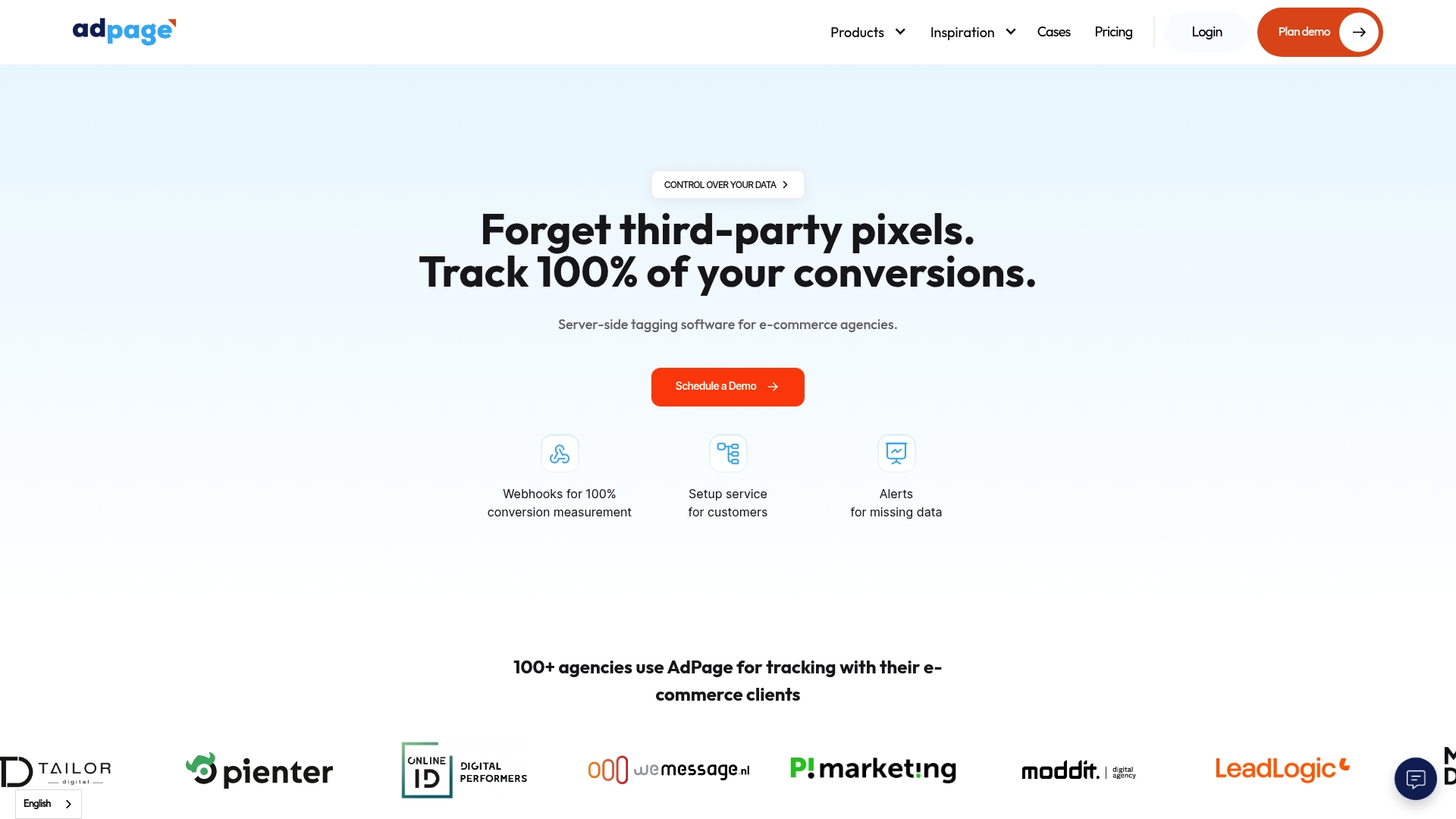Online marketing is changing fast, and the rules for 2025 look nothing like last year. Suddenly, a single second can decide if you gain or lose a customer, with even a one second delay cutting conversions by up to 7 percent. You might think the real challenge is mastering the newest platforms or chasing trendy tactics. Actually, what really sets successful businesses apart is a clear, data-driven approach that links every online move back to measurable goals.
Table of Contents
- Key Elements Of Online Marketing Basics
- Building A Results-Driven Digital Strategy
- Optimizing Campaigns For Better Conversion Rates
- Tracking, Measuring And Improving Online Success
Quick Summary
| Takeaway | Explanation |
|---|---|
| Understanding Digital Marketing Channels | Businesses must develop a multifaceted strategy incorporating SEO, content marketing, and social media to effectively reach their audiences. |
| Creating a Data-Driven Strategy | Establishing SMART goals and conducting a comprehensive digital asset audit are crucial to align marketing efforts with business objectives. |
| Optimising for Conversion Rates | Systematic landing page improvements, A/B testing, and advanced personalization techniques are key to converting website visitors into customers. |
| Continuous Measurement and Adaptation | Implementing a feedback loop for data analysis allows organizations to identify areas for improvement and make strategic adjustments in real time. |
Key Elements of Online Marketing Basics
Online marketing requires a strategic approach that integrates multiple digital channels and techniques to effectively reach and engage target audiences. Understanding the fundamental elements of online marketing provides businesses with a robust framework for digital success.

Digital Marketing Channel Foundations
Successful online marketing begins with a comprehensive understanding of core digital channels. Research from Emeritus highlights that businesses must develop a multifaceted strategy encompassing search engine optimization (SEO), content marketing, and social media engagement.
SEO remains a critical component of online marketing basics. By optimizing website content and structure, businesses can improve their visibility in search engine results, driving organic traffic and increasing potential customer interactions. This involves careful keyword research, technical website optimization, and creating high-quality, relevant content that addresses user search intent.
Content Strategy and Audience Engagement
Content marketing represents a powerful approach to connecting with potential customers. The strategy involves creating valuable, relevant content designed to attract and retain a clearly defined audience. Effective content marketing goes beyond simple promotion, focusing instead on providing genuine value through informative articles, engaging videos, podcasts, and interactive resources.
Key elements of a robust content strategy include:
- Audience Understanding: Developing detailed customer personas to guide content creation
- Consistent Messaging: Maintaining a coherent brand voice across all digital platforms
- Value Proposition: Creating content that solves problems or addresses specific customer needs
Performance Tracking and Analytics
Measuring marketing performance is crucial for continuous improvement. Businesses must implement comprehensive analytics systems that track key performance indicators (KPIs) across different digital marketing channels. This involves monitoring metrics such as website traffic, conversion rates, engagement levels, and return on investment.
Google Analytics provides powerful tools for tracking digital marketing performance, enabling businesses to gain insights into user behavior, traffic sources, and campaign effectiveness. By regularly analyzing these metrics, marketers can refine their strategies, allocate resources more effectively, and optimize their online marketing approach.
The digital marketing landscape continues to evolve rapidly, requiring businesses to remain adaptable and informed about emerging technologies and consumer behavior trends. Successful online marketing demands a holistic approach that integrates multiple channels, focuses on creating genuine value, and maintains a data-driven perspective.

Building a Results-Driven Digital Strategy
Creating a results-driven digital strategy requires a systematic approach that transforms marketing efforts from random activities into purposeful, measurable initiatives. The foundation of an effective digital strategy lies in understanding your business objectives and aligning them with precise marketing tactics.
Goal Setting and Strategic Alignment
Research from the American Marketing Association emphasizes the importance of establishing SMART goals for digital marketing success. These goals must be Specific, Measurable, Achievable, Relevant, and Time-bound, providing a clear roadmap for marketing efforts.
Developing comprehensive buyer personas becomes crucial in this process. By deeply understanding target audience demographics, behaviors, and pain points, businesses can craft more targeted and effective marketing strategies. Marketing research suggests that personalized approaches can significantly improve engagement and conversion rates.
Comprehensive Digital Asset Auditing
Before implementing any new strategy, conducting a thorough audit of existing digital channels is essential. This process involves critically examining current marketing assets, website performance, content quality, and existing digital infrastructure. Marketing experts recommend a comprehensive review that identifies:
- Performance Gaps: Areas where current digital assets are underperforming
- Optimization Opportunities: Potential improvements in content and user experience
- Technical Limitations: Infrastructure challenges that might hinder marketing effectiveness
Data-Driven Strategy Implementation
Successful digital strategies rely on continuous measurement and adaptation. Implementing robust analytics and tracking mechanisms allows businesses to monitor performance in real-time, making data-informed decisions that drive marketing effectiveness.
Google Analytics provides powerful tools for tracking key performance indicators, enabling marketers to understand user behavior, measure campaign effectiveness, and identify areas for improvement. The key is to establish a feedback loop that allows for rapid iteration and optimization.
Understanding the interconnectedness of different digital marketing channels is crucial. A holistic approach considers how various platforms work together, creating a unified marketing ecosystem that maximizes reach and engagement. This means integrating efforts across search, social media, email marketing, and other digital touchpoints to create a cohesive and compelling brand narrative.
The most successful digital strategies remain flexible and adaptable. As technology and consumer behaviors evolve, marketing approaches must be willing to pivot and embrace new opportunities. This requires a culture of continuous learning, experimentation, and data-driven decision-making.
Ultimately, a results-driven digital strategy is not about implementing the most trendy marketing techniques, but about creating a systematic, measurable approach that directly supports business objectives and delivers tangible value to both the organization and its target audience.
Optimising Campaigns for Better Conversion Rates
Conversion rate optimization represents a critical strategy for transforming website visitors into engaged customers. By systematically improving various elements of digital marketing campaigns, businesses can significantly enhance their online performance and revenue generation.
Landing Page and User Experience Optimization
Research from Khris Digital reveals that page load speed dramatically impacts conversion rates. Even a one-second delay can reduce conversions by up to 7%, highlighting the importance of technical performance in digital marketing strategies.
Optimizing landing pages requires a multi-dimensional approach. This involves creating clear, compelling headlines, using persuasive visual elements, and ensuring seamless navigation. The goal is to reduce cognitive friction and guide visitors toward desired actions with minimal resistance.
To help clarify the statistics and actionable insights for landing page and form optimization, the following table summarizes key performance findings mentioned in this section:
| Factor | Impact on Conversion Rate | Detail/Statistic |
|---|---|---|
| Page Load Time | ↓ Conversions by up to 7% | One-second delay can cut conversions |
| Simplifying Forms | ↑ Conversions by up to 160%. | Fewer form fields, less cognitive load |
| Mobile Form Optimization | ↑ User Engagement | Especially effective on mobile devices |
| Clear Headlines & Visual Elements | ↑ Conversion Likelihood | Reduces friction, guides action |
Strategic A/B Testing Techniques
Conversion rate optimization experts recommend implementing systematic A/B testing to compare different marketing elements. This methodology allows businesses to scientifically evaluate variations in web copy, design, and user interface to determine the most effective configurations.
Key areas for A/B testing include:
- Call-to-Action Buttons: Testing different colors, sizes, and text
- Page Layouts: Comparing various design structures
- Form Design: Evaluating form length and complexity
Research from Amraan Del Ma indicates that simplifying forms can boost conversions by up to 160%. By reducing the number of form fields and lowering cognitive load, businesses can significantly improve user engagement, particularly on mobile devices.
Personalization and Targeting Strategies
Advanced conversion optimization goes beyond technical adjustments. Implementing sophisticated personalization techniques allows businesses to create more targeted, relevant experiences for different audience segments.
This involves leveraging data analytics to understand user behavior, preferences, and interaction patterns. By delivering tailored content, recommendations, and user experiences, businesses can increase the likelihood of conversion.
Technology such as machine learning and AI enables more granular personalization, allowing real-time content adaptation based on user characteristics and historical interactions. Google Analytics provides powerful tools for tracking these nuanced user behaviors and informing personalization strategies.
Successful conversion rate optimization requires a holistic, data-driven approach. It demands continuous testing, learning, and refinement. Businesses must remain agile, regularly analyzing performance metrics and being prepared to implement strategic changes based on empirical evidence.
Ultimately, conversion rate optimization is not about implementing generic tactics, but about creating a deep understanding of user needs, motivations, and barriers. By combining technical optimization, strategic testing, and sophisticated personalization, businesses can develop more effective digital marketing campaigns that genuinely resonate with their target audience.
Tracking, Measuring and Improving Online Success
Tracking and measuring online marketing performance is fundamental to understanding and enhancing digital strategy effectiveness. By implementing systematic measurement approaches, businesses can transform raw data into actionable insights that drive continuous improvement.
Essential Web Analytics and Performance Metrics
Research from Harvard Business School emphasizes the critical importance of defining clear, measurable goals and utilizing comprehensive key performance indicators (KPIs). These metrics provide a structured framework for evaluating marketing campaign performance across different digital channels.
Web analytics tools play a pivotal role in this process. Scientific research highlights the significance of collecting granular data on website traffic sources, visitor behavior, and navigation paths. By understanding these intricate details, businesses can identify strengths, weaknesses, and opportunities for optimization.
Data Integration and Comprehensive Measurement
Computing research suggests that integrating multiple data sources provides a more holistic view of marketing performance. This approach involves combining diverse datasets such as:
- Sales Data: Direct revenue and conversion information
- Clickstream Analytics: user interaction and navigation patterns
- Customer Demographics: Detailed audience segmentation insights
By synthesizing these varied data points, organizations can develop a nuanced understanding of their digital marketing effectiveness that goes beyond surface-level metrics.
Continuous Improvement and Strategic Adaptation
Google Analytics offers sophisticated tools for tracking performance metrics, enabling businesses to monitor real-time data and identify trends. The key to successful online marketing lies not just in measurement, but in the ability to rapidly interpret and act on these insights.
Effective performance tracking requires establishing a continuous feedback loop. This means regularly reviewing performance data, identifying areas for improvement, and implementing strategic adjustments. Machine learning and advanced analytics technologies are increasingly enabling more dynamic and predictive approaches to performance measurement.
Successful online marketing demands a proactive approach to data analysis. Organizations must cultivate a culture of data-driven decision-making, where insights are quickly translated into actionable strategies. This involves not just collecting data, but developing the analytical capabilities to extract meaningful, strategic insights.
The most successful digital marketing strategies view measurement not as a static process, but as a dynamic, ongoing dialogue with audience behavior. By maintaining flexibility, embracing technological advances, and consistently refining measurement approaches, businesses can develop increasingly sophisticated and effective online marketing strategies.
Ultimately, tracking and measuring online success is about transforming complex data into clear, strategic understanding. It requires technical sophistication, analytical thinking, and a commitment to continuous learning and adaptation.
Frequently Asked Questions
What are the key elements of online marketing for 2025?
Successful online marketing in 2025 involves understanding digital marketing channels, creating a data-driven strategy, optimizing for conversion rates, and continuous measurement and improvement.
How can businesses improve their conversion rates?
Businesses can enhance conversion rates by optimizing landing pages, implementing A/B testing, and utilizing personalization techniques to provide tailored user experiences.
What is the importance of setting SMART goals in digital marketing?
Setting SMART goals (Specific, Measurable, Achievable, Relevant, Time-bound) is vital as it provides a clear roadmap for marketing efforts and aligns strategies with business objectives.
How can data analytics improve online marketing performance?
Data analytics allows businesses to track performance metrics, understand user behavior, and identify areas for improvement, enabling them to make informed, data-driven decisions.
Take Control of Your Data and Unlock Real Marketing Growth
Are you struggling to get clear, reliable insights from your online marketing campaigns? The article on Online Marketing Basics for 2025 uncovered a pressing pain point: even a small delay or missing data can cost you real conversions and revenue. Without precise conversion tracking and data collection, your data-driven strategies quickly lose power. Traditional analytics are falling behind, failing to deliver the accuracy businesses need for true performance measurement, which the article highlighted as essential for adapting and improving results.

Do not let data loss or unreliable metrics hold back your growth. Elevate your conversion tracking with AdPage's server-side tagging solutions. Our platform lets you monitor 100% of conversions, solve the consent management challenge, and gain GDPR-compliant insights for every campaign. Connect with onboarding experts and integrate seamlessly with top e-commerce systems. Discover how you can achieve consistent improvement in your digital strategy by visiting our main page now and start seeing measurable results from every pound you spend.



.png)
